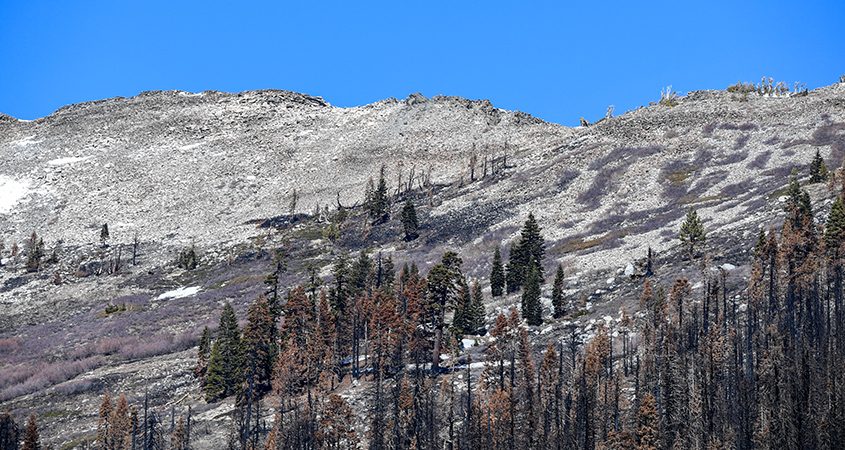 Nearby mountain peaks with only small patches of snow near the Phillips Station meadow on April 1, 2022, shortly before the California DWR's last snow survey of the 2021-22 season in the Sierra Nevada. Photo: Ken James/California Department of Water Resources
Nearby mountain peaks with only small patches of snow near the Phillips Station meadow on April 1, 2022, shortly before the California DWR's last snow survey of the 2021-22 season in the Sierra Nevada. Photo: Ken James/California Department of Water Resources California Drought Demands Statewide Water Conservation Effort
California is in the third year of drought and water agencies and officials statewide are urging residents and businesses to increase their water conservation.
April 1 is typically when the snowpack is at its highest, however the statewide snowpack likely peaked in early-March this year and the Northern Sierra snowpack peaked in mid-January, according to the California Department of Water Resources.
“The conditions we are seeing today speak to how severe our drought remains,” said DWR Director Karla Nemeth on April 1. “DWR has been planning for the reality of a third dry year since the start of the water year on October 1. While DWR has made significant investments in forecasting technology and other tools to ensure we make the most out of the snowmelt we do receive, water conservation will remain our best tool in the face of this ongoing drought and the statewide impacts of a warming climate. All Californians must focus on conserving water now.”
While DWR has made significant investments in forecasting technology and other tools to ensure we make the most out of the snowmelt we do receive… All Californians must focus on conserving water now. – Karla Nemeth, DWR Director pic.twitter.com/Te039jYifp
— CA – DWR (@CA_DWR) April 1, 2022
Water conservation critical
While the state continues to take necessary actions to help extend the state’s existing water supply, state agencies are asking all Californians to do their part now to conserve as much water as possible to make it last. Governor Gavin Newsom has also called on all Californians to voluntarily reduce their water use by 15% with simple measures to protect water reserves.
Today we celebrate California's beautiful state flower – the CA poppy! Plant a poppy today and continue to be water smart. More outdoor water conservation tips here: https://t.co/yQ7IaXbuq8
–#california #poppy #saveourwater pic.twitter.com/XPkQEZ6p16— Save Our Water (@saveourwater) April 6, 2022
WaterSmart moves to make now
Typical gardening activities such as landscaping, irrigation, and use of fertilizers and pesticides, can lead to stormwater pollution if not done properly. Pollutants such as garden chemicals, soil and sediment, and yard waste can be carried to storm drains by rain and irrigation runoff and end up in our local waterways and ocean without being treated.
No lawn needs daily watering in any season. It’s important to only use what you need. Find irrigation tips as you adjust your watering schedule for the summer here: https://t.co/3fPljY47bj
–#SaveOurWater #cawater #cadrought #california #conservation #drought #waterconservation pic.twitter.com/rn3apb51vG— Save Our Water (@saveourwater) April 6, 2022
Here are some earth-friendly guidelines for WaterSmart gardening and a pollution-free environment.
Plan and Plant Wisely
When planning your landscape, design your landscape to capture water and minimize run-off. Install rain gardens or dry creek beds; use permeable surfaces to allow water to soak into the soil; and direct water from downspouts to landscaped areas. Get planting ideas by checking the California Native Plant Society of San Diego website. When planting, use drought-tolerant or native plants to reduce the amount of water, fertilizers, and pesticides needed and group plants with similar water, sun, and soil needs. Check out the San Diego Water Authority’s Nifty 50 Plants for WaterSmart Landscapes for plants best suited for our climate as well as helpful water-savings tips.
Mulch/Compost Liberally
Use mulch to reduce the need for fertilizers, hold water in the soil, and prevent erosion of exposed soil patches. Sediment is a common pollutant in our waterways and comes from eroded soils. Opt for healthy compost to add nutrients to your soil and further lock in moisture and reduce waste.
Thanks to customers like Paul and Bernice Rodriguez, @SweetwaterAuth is already meeting state water use reduction goals. Learn more about how they are saving water in this story from @nbcsandiego! https://t.co/cC0jImBZci
— Sweetwater Authority (@SweetwaterAuth) April 6, 2022
Water Smartly
Avoid water waste by repairing leaking or broken sprinklers, adjusting misdirected sprinklers so water does not spray on driveways or sidewalks, and using irrigation methods such as drip irrigation and soaker hoses. Water in short cycles to allow water to infiltrate into the ground, and in the early morning or late evening when it’s cooler outside to reduce water loss due to evaporation.
Learn how much water your lawn and garden actually needs by observing an entire watering cycle (watering guide) or sign up for a free WaterSmart Checkup to receive water-saving recommendations. Rebates may be available to help you prevent over irrigation.
Apply Fertilizers/Pesticides Sparingly
Be sure to read labels and follow directions to avoid improper use and application of fertilizers and pesticides which can lead to stormwater pollution and contribute to toxic harmful algal blooms in both fresh and coastal waters. Only apply chemicals when it is not windy and more than 48-hours from a rainstorm. When possible, use organic or slow-release fertilizers to minimize leaching.
Clean Up Thoroughly
Sweep up spills from fertilizers and pesticides immediately. Blow, rake, or sweep up leaves and debris into a pile for proper disposal into a green waste container with a lid. To make clean up easier and prevent stormwater pollution, protect stockpiles and materials from wind and rain by storing them under tarps or secured plastic sheeting.
Learn more about WaterSmart and sustainable landscaping practices by reviewing the WaterSmart Landscaping Watering Guide in San Diego County and San Diego Sustainable Landscaping Guidelines. Explore even more by participating in the numerous Earth Day/Pollution Prevention events offered throughout San Diego County during the month of April.



